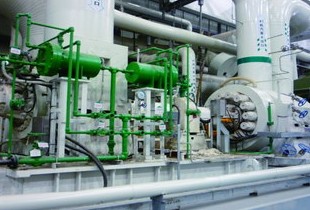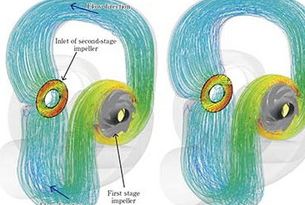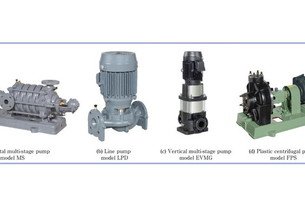Issue No. 257〔Technical Papers〕
Automated Design Environment for Custom Turbo Machinery
–Automated Design of Centrifugal Compressors Using Parametric Design–
Author
Masahiro KASHIWAI*
Kazuharu ISHIZUKA*
Akira YOSHIDA*
Hailong TENG*
Koichi HAYAMA*
Shin KONOMI*
- *
Elliott Ebara Turbomachinery Corporation
There are laws of similarity (affinity laws) regarding the design of turbo machinery, and in theory, it is possible to implement automated machine designs. In this paper, we present an automated design environment that was developed for centrifugal compressors manufactured and sold by Elliott Group. First, we developed a basic design calculation program that automatically incorporates each customer’s requirements into the design specifications. Next, in the detailed design stage, we sorted and classified all components into two types. One type consisted of “standard parts” and the other type consisted of “customized parts,” which were designed specifically to meet each customer’s requirements. In addition, we had applied a parametric design process for feature- and parametric-modeling 3D-CAD. We took advantage of CAD associativity so that the 3D data and 2D drawing data were always correlated. This design approach of placing all of the design information into the 3D models to be the center of the design is called a “model-centric” approach.
This newly developed automated design environment has been successful in reducing the design time by 70% in comparison with the previous design method. The 3D design information is also used for the manufacturing process, resulting in improved product quality and manufacturing efficiency.
Keywords: Design automation, 3D-CAD, PLM, Centrifugal compressor, Parametric design
1. Introduction
Equipment such as centrifugal compressors, axial compressors, steam turbines, and power recovery expanders manufactured and sold by Elliott Group are used in all kinds of industries that require rotating machinery such as oil and gas plants, oil refining plants, petrochemical plants, steel plants, power plants, sugar plants, paper mills, vegetable oil treatment plants, and waste treatment facilities of local governments. Centrifugal compressors, which comprise one of our core products, are optimized in accordance with the requirements of the customers such as pressure and flow rate and type of fluid that flows through the centrifugal compressor (e.g. corrosive fluid or fluid containing impurities). In view of that, manufacturers of centrifugal compressors have to study each customer’s requirements every time they receive an order and then design and manufacture the compressors accordingly. Furthermore, since centrifugal compressors often serve as a central component of large-scale plants (e.g. oil and gas plants, oil refining plants, and petrochemical plants) and their applications are wide ranging, it is difficult to stockpile standard products or components in advance. Furthermore, it is highly unlikely that customers would order more than one centrifugal compressor with exactly the same specifications. For that reason, all centrifugal compressors developed and manufactured by Elliott Group are custom-made “engineered to order” products. Figure 1 shows the configuration of the main components of a standard compressor.

Fig. 1 Configuration of the main components of a standard centrifugal compressor
2. Issues to be resolved
When Elliott Group receives an order from a customer, we initiate the design, procure raw materials, manufacture the necessary components, and assemble the components in the proper sequence, test per customers’ requirements, and deliver the finished product to the customer (Figure 2).

Fig. 2 Entire flow of tasks from the design process to product delivery
In other words, a smooth and error-free start to the engineering and design process, which is the first process after receiving an order, will result in a shorter lead time to product delivery.
The design process of centrifugal compressors is roughly divided into two phases, namely, the basic design (layout) phase and the detailed design phase. In the basic design phase, raw materials suitable for the customer’s required specifications are selected and models of the key components and other matters are studied and determined.
In the detailed design phase, on the other hand, individual components that configure the centrifugal compressor are designed and their designs are submitted in the form of 2D manufacturing drawings. When we design individual components in the detailed design phase, we carry out the “design reuse and revise approach” where previously developed design models and drawings that have similar design specifications are copied and minor changes are incorporated. Generally, there are proportion rules for designing turbomachinery using parameters such as required pressure, flow rate, and fluid density. Because of these design rules, the components basically have unique shapes. Therefore, the design of a component will always be the same in principle depending on the customer’s requirements regardless of the person who designs it.
However, there were two issues in the detailed design phase of Elliott Group 1). One of the issues was that the process of selecting drawings as sources for design reuse depended on each designer’s expertise and the variations in the similarities. As a result, we accumulated a large number of drawings that were created from the original drawings. Another issue was that the quality of drawings largely depended on the experience of the designers and the age of drawing copied from because they had to select the drawings to be used as sources for design reuse from a large number of existing design drawings while having to consider whether critical modifications were incorporated in the new design drawings (Figure 3).

Fig. 3 Management of design reuse and revise approach
In consideration of the issues we face, we invested a lot of time on designing a single centrifugal compressor and submitting all drawings. There were cases where the coordination between design process and raw material procurement process in downstream did not work well because the design process took longer than anticipated, which affected the manufacturing process, caused rework and delayed product delivery to a customer.
Even after the design drawings were submitted, there were cases where we found a number of defects, for example, interference between manufactured components during assembly and misalignment of mounting positions. As a result, we had to revise and reissue the drawings. At that time, measures taken to prevent such mistakes in the designing process, resulted in increased design time at the start of each project, delaying start of procurement and manufacturing which extended delivery to the customer.
3.New approach for solutions
3.1 Classifying components into customized parts and standard parts and adopting a parametric design
Elliott Group has started efforts to resolve the issues concerning the design process. First of all, we have integrated a wide range of calculation tasks required in the basic design phase, such as selection of key components and rotor vibration analysis in order to enable automatic calculation. This new design calculation program is called “E-Shell,” and it can automatically output design specifications based on a customer’s required specifications (Figure 4).

Fig. 4 Automated design calculations
Elliott Group also adopted parametric design as a design method in order to resolve the issues concerning the design reuse and revise approach. In the parametric design process, basic shapes known as “features” are assigned parameters such as dimension data and the components are designed by combining these features. For example, when you design a cylindrical shape, it has the parameters of diameter and length. Once the relationship between these two parameters is defined, the length of the cylindrical shape can be automatically changed by changing the diameter. In the previous design process using 2D CAD, the designers had to change and correct parameters such as dimension information separately as well as manually revising geometry entities. The use of the parametric design function enables changing the parameters in sync.
When Elliott Group performed full remodeling of a centrifugal compressor, we decided to apply a parametric design using the feature- and parametric-modeling 3D-CAD called Creo ParametricTM*2(previously known as Pro Engineer) developed by PTC Inc. In this design process, the components were classified into two types (Figure 5). One type consisted of standard parts and the other type consisted of customized parts. The standard parts are standardized discrete components that can be used for any customer’s required specifications whereas the customized parts are those that must be designed specifically to meet each customer’s required specifications.

Fig. 5 Customized parts and standard parts
For example, in the case of designing a centrifugal compressor, the performance of the compressor is determined by the impellers and inner barrel. Components such as those are defined as customized parts. The components such as a shaft (rotor) are also defined as customized parts since their length is set based on the number of impellers. On the other hand, components such as bearings and end walls are defined as standard parts, and components that can be standardized are also defined as standard parts, as much as possible. For example, the casing size, except for length is defined as standard parts since it is a type of pressure vessel and the customers often inquire about its track record in the market. The shape of a shaft end is also defined as standard parts since it is difficult to properly manage them if they are designed and manufactured for each customer’s requirements.
After the components for configuring the centrifugal compressor were classified into standard parts and customized parts in this manner, the number of data items to be processed as parameters in the parametric design process came to about 10 000. Among these, about 7 000 to 8 000 data items were likely to have the same values regardless of the person who designed them. The values of the remaining 2 000 data items could be slightly different depending on the knowledge and experience of the designers. This implicit knowledge of each designer was transformed into explicit knowledge in terms of parameters of the parametric design process by classifying the components into standard parts and customized parts. The transformation of the design process into explicit knowledge made it possible to hand down technologies from experienced designers to novice designers and resulted in higher productivity as well. The purpose of this design process is to generate the same results and accomplish the design tasks at the same speed regardless of the person who carries out the work.
- *1
Excel is a registered trademark of Microsoft Corporation in the United States and/or other countries.
- *2
Creo Parametric is a trademark of PTC Inc. or its subsidiaries in the United States and in other countries.
3.2 Automated 3D data generation
We created a master model for the configuration components that are classified as customized parts . As soon as we receive an order, 3D master data is copied from a master model based on the design specifications that were automatically calculated using E-Shell. For example, the shape of a shaft used in a centrifugal compressor is changed in accordance with the customer’s requirements. The drawing data is created using CAD associativity provided by Creo Parametric. Creo Parametric CAD associativity ensures that the 3D data and 2D drawing data are always correlated, and the changes made to the 3D data are accurately incorporated in the 2D drawing data (Figure 6).

Fig. 6 Example of CAD associativity
Elliott Group changed the design process from a drawing-centric approach to a model-centric approach where 3D data is used as the main design information and the 2D drawing data is just assumed as a projection of the 3D data. We also decided to create the 3D data according to each customer’s requirements from a master model for each order received without using the past manual selection design reuse and revise approach. Creating identical designs by all designers has become possible by designing configuration components that are classified as customized parts and selecting the optimal components from the standard parts library, which has been prepared in advance.
Furthermore, when 3D data is created from the design specifications, a program is created and loaded into Creo Parametric. This process enables a series of tasks to be performed in the design process to be executed automatically and requires minimal human operation (Figure 7).

Fig. 7 Automated design based on customer’s design specifications
This automated design environment was implemented using only the in-house resources of Elliott Group. One of the reasons for using only in-house resources was to prevent the system used for automated design from becoming a black box by using outside resources. Users need to know how the automation tool sworks for issues and future improvements. Another reason was that we did not come across outside resources that could provide solutions to the issues faced by Elliott Group.
4. Effects of newly introduced automated design environment
In conventional machining operations, an intermediary file containing Drawing eXchange Format (DXF) data is created from the 2D drawing data and loaded into Numerical Control (NC) machine tools as workpiece data. The tolerance values of the drawing data to be loaded into NC machine tools during this process often were not set to the tolerance center values and therefore we had to correct the workpiece data when we created the NC program.
The machining of impellers and inner barrels requires 3D data. In the past, this data is not associated with the drawing data and is used for manufacturing purposes only. This issue was resolved by changing the design process to the feature- and parametric-modeling 3D-CAD design process.
As a result, the dimension and tolerance values are set to the tolerance center values and it is now possible to utilize the 3D data without having to make any modifications to the NC program workpiece data. Since the 3D data created during the design process can be used as is in the manufacturing process without time lags, this new design process has improved product quality and reduced the lead time2).
Previously, a lot of time was required for the design processes, but we succeeded in reducing the designing time by 70% with the automated design process. Furthermore, the drawing data created from the 3D data using Creo Parametric can be passed on to the downstream processes by simply adjusting the view and note positions for indicating a drawing scale and dimensions. Therefore, even a designer without sufficient designing knowledge or experience in CAD operation can edit the drawings as long as they are provided with clear drawing editing instructions and procedure. Also, it has become possible to assign the tasks that must be performed by a designer and the tasks that can be performed by others separately.
Since the designing tasks of a centrifugal compressor were automated, the mistakes that occurred during manual designing have been reduced substantially. Consequently, the designers’ motivation for their work has improved significantly. Before the automated design process was introduced, there was no room for margin in the working environment since the drawings often could not be submitted before the deadline. Because of such working conditions, sometimes the designers were forced to submit drawings without properly checking them in order to meet the deadline.
As a result, design mistakes were detected during the manufacturing process and the designers had to hasten to correct those mistakes, which cost the whole process extra time. With the previous design process, the designers were trapped in a downward spiral. The introduction of the automated design process significantly improved this situation. Today, the designers are able to submit the drawing data faster, the accuracy of the drawing data has improved, and the departments of the downstream processes are highly appreciative of the promptly submitted design drawings. Also for any mistakes that still may occur with the new process, the corrective actions can be made in the Master Models and programing so that future orders will not repeat that mistake.
Furthermore, the design review was previously conducted using 2D drawing data by the manufacturing department and maintenance department. Now, when the design review is held between design, manufacturing, and maintenance departments, the design of products to be actually manufactured can be evaluated visually using 3D data, which makes it easier to understand the product design. We also provide the 3D data to a customer who placed an order (upon request), which makes Elliott Group gain more customer satisfaction.
5. Future prospects
In addition to the abovementioned automated design process using a feature- and parametric-modeling 3D-CAD, Elliott Group has also automated the creation of Bill Of Materials (BOM), which is a list of components required to manufacture a product. We are creating a master BOM automatically, using a BOM creation program called BOM Master based on the design specifications that are also automatically calculated using E-Shell. Also, all data including design specifications, 3D data, drawing data, and BOM are managed by the Product Lifecycle Management (PLM) system (Figure 8). This working environment makes it easy to perform the maintenance work required after the product shipment since the maintenance personnel can get all the necessary information (e.g. drawings, BOM) by simply accessing the PLM system.

Fig. 8 Entire structure of the design environment related to centrifugal compressors
Elliott Group is planning to advance the automated design process of a centrifugal compressor even further. There are still some tasks that need to be performed manually at present. We are making an effort to automate those manual tasks and aiming to implement a working environment where all data including design specifications, 3D data, drawing data, and BOM can be created automatically by just entering some of a customer’s required specifications and the product serial number. This automated design environment is going to reduce the design time even further. Reduction of the manufacturing lead time is one of the primary customer demands.
If a high-standard proposal can be submitted to a customer speedily during an inquiry by applying the front-loading method to move up the schedule and improve the conventional design process, the probability of receiving an order increases significantly. We are going to continue this activity for reducing a design lead time in order to move up the manufacturing process to an earlier time as soon as we receive an order so that we can distinguish ourselves from competitor companies. Our ultimate goal is to create a work environment that enables us to complete the design process when the customer makes an inquiry, in other words, a total automated design process that requires zero time. Furthermore, we are planning to expand the automated design environment used for centrifugal compressors to the development of other products such as steam turbines. While these efforts are being carried out, Elliott Group is going to review the design process itself in order to improve our design process capabilities even further.
References
- 1)
Nikkei BP: Nikkei Monozukuri, monthly magazine, 2016 December issue (pp. 48-49)
- 2)
Yoshiro Fukasaku, Shin Konomi, and Naoyuki Hasegawa, “Innovative Design and Manufacture of Process Gas Centrifugal Compressors,” Ebara Engineering Review No. 237 (2012-10), (pp.54-59)
Recommended articles
Inquiry about Ebara Engineering Review



